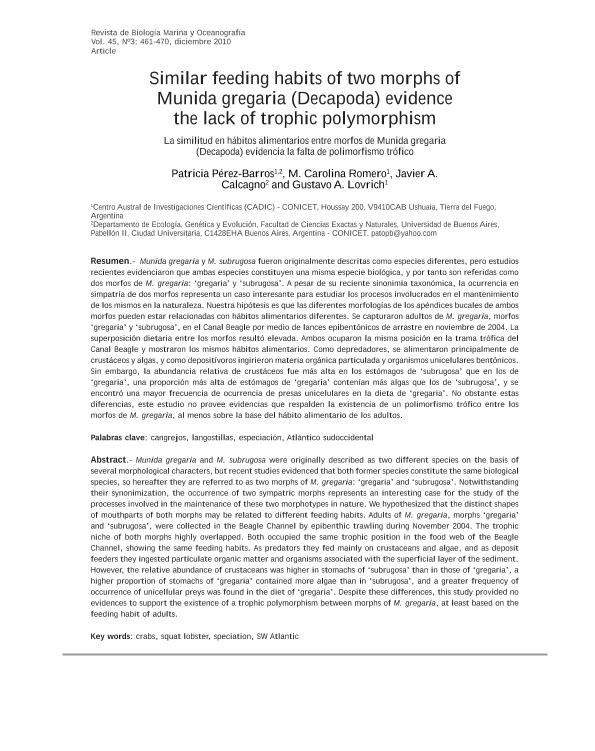Mostrar el registro sencillo del ítem
dc.contributor.author
Perez Barros, Patricia

dc.contributor.author
Romero, Maria Carolina

dc.contributor.author
Calcagno, Javier Angel

dc.contributor.author
Lovrich, Gustavo Alejandro

dc.date.available
2017-02-08T20:51:16Z
dc.date.issued
2010-12
dc.identifier.citation
Perez Barros, Patricia; Romero, Maria Carolina; Calcagno, Javier Angel; Lovrich, Gustavo Alejandro; Similar feeding habits of two morphs of Munida gregaria (Decapoda) evidence the lack of trophic polymorphism; Universidad de Valparaíso. Facultad de Ciencias del Mar; Revista de Biología Marina y Oceanografía; 45; 3; 12-2010; 461-470
dc.identifier.issn
0717-3326
dc.identifier.uri
http://hdl.handle.net/11336/12733
dc.description.abstract
Munida gregaria and M. subrugosa were originally described as two different species on the basis of several morphological characters, but recent studies evidenced that both former species constitute the same biological species, so hereafter they are referred to as two morphs of M. gregaria: `gregaria' and `subrugosa'. Notwithstanding their synonimization, the occurrence of two sympatric morphs represents an interesting case for the study of the processes involved in the maintenance of these two morphotypes in nature. We hypothesized that the distinct shapes of mouthparts of both morphs may be related to different feeding habits. Adults of M. gregaria, morphs `gregaria' and `subrugosa', were collected in the Beagle Channel by epibenthic trawling during November 2004. The trophic niche of both morphs highly overlapped. Both occupied the same trophic position in the food web of the Beagle Channel, showing the same feeding habits. As predators they fed mainly on crustaceans and algae, and as deposit feeders they ingested particulate organic matter and organisms associated with the superficial layer of the sediment. However, the relative abundance of crustaceans was higher in stomachs of `subrugosa' than in those of `gregaria', a higher proportion of stomachs of `gregaria' contained more algae than in `subrugosa', and a greater frequency of occurrence of unicellular preys was found in the diet of `gregaria'. Despite these differences, this study provided no evidences to support the existence of a trophic polymorphism between morphs of M. gregaria, at least based on the feeding habit of adults.
dc.description.abstract
Munida gregaria y M. subrugosa fueron originalmente descritas como especies diferentes, pero estudios recientes evidenciaron que ambas especies constituyen una misma especie biológica, y por tanto son referidas como dos morfos de M. gregaria: `gregaria' y `subrugosa'. A pesar de su reciente sinonimia taxonómica, la ocurrencia en simpatría de dos morfos representa un caso interesante para estudiar los procesos involucrados en el mantenimiento de los mismos en la naturaleza. Nuestra hipótesis es que las diferentes morfologías de los apéndices bucales de ambos morfos pueden estar relacionadas con hábitos alimentarios diferentes. Se capturaron adultos de M. gregaria, morfos `gregaria' y `subrugosa', en el Canal Beagle por medio de lances epibentónicos de arrastre en noviembre de 2004. La superposición dietaria entre los morfos resultó elevada. Ambos ocuparon la misma posición en la trama trófica del Canal Beagle y mostraron los mismos hábitos alimentarios. Como depredadores, se alimentaron principalmente de crustáceos y algas, y como depositívoros ingirieron materia orgánica particulada y organismos unicelulares bentónicos. Sin embargo, la abundancia relativa de crustáceos fue más alta en los estómagos de `subrugosa' que en los de `gregaria', una proporción más alta de estómagos de `gregaria' contenían más algas que los de `subrugosa', y se encontró una mayor frecuencia de ocurrencia de presas unicelulares en la dieta de `gregaria'. No obstante estas diferencias, este estudio no provee evidencias que respalden la existencia de un polimorfismo trófico entre los morfos de M. gregaria, al menos sobre la base del hábito alimentario de los adultos.
dc.format
application/pdf
dc.language.iso
eng
dc.publisher
Universidad de Valparaíso. Facultad de Ciencias del Mar
dc.rights
info:eu-repo/semantics/openAccess
dc.rights.uri
https://creativecommons.org/licenses/by-nc-sa/2.5/ar/
dc.subject
Crab
dc.subject
Squat Lobster
dc.subject
Speciation
dc.subject
Sw Atlantic
dc.subject.classification
Ecología

dc.subject.classification
Ciencias Biológicas

dc.subject.classification
CIENCIAS NATURALES Y EXACTAS

dc.title
Similar feeding habits of two morphs of Munida gregaria (Decapoda) evidence the lack of trophic polymorphism
dc.title
La similitud en hábitos alimentarios entre morfos de Munida gregaria (Decapoda) evidencia la falta de polimorfismo trófico
dc.type
info:eu-repo/semantics/article
dc.type
info:ar-repo/semantics/artículo
dc.type
info:eu-repo/semantics/publishedVersion
dc.date.updated
2017-02-07T18:02:57Z
dc.identifier.eissn
0718-1957
dc.journal.volume
45
dc.journal.number
3
dc.journal.pagination
461-470
dc.journal.pais
Chile

dc.journal.ciudad
Valparaiso
dc.description.fil
Fil: Perez Barros, Patricia. Consejo Nacional de Investigaciones Científicas y Técnicas. Centro Austral de Investigaciones Científicas; Argentina. Universidad de Buenos Aires. Facultad de Ciencias Exactas y Naturales. Departamento de Ecología, Genética y Evolución; Argentina
dc.description.fil
Fil: Romero, Maria Carolina. Consejo Nacional de Investigaciones Científicas y Técnicas. Centro Austral de Investigaciones Científicas; Argentina
dc.description.fil
Fil: Calcagno, Javier Angel. Consejo Nacional de Investigaciones Científicas y Técnicas; Argentina. Universidad de Buenos Aires. Facultad de Ciencias Exactas y Naturales. Departamento de Ecología, Genética y Evolución; Argentina
dc.description.fil
Fil: Lovrich, Gustavo Alejandro. Consejo Nacional de Investigaciones Científicas y Técnicas. Centro Austral de Investigaciones Científicas; Argentina
dc.journal.title
Revista de Biología Marina y Oceanografía

dc.relation.alternativeid
info:eu-repo/semantics/altIdentifier/url/http://www.revbiolmar.cl/index.php?option=com_content&view=article&id=414&Itemid=68&lang=es
dc.relation.alternativeid
info:eu-repo/semantics/altIdentifier/doi/http://dx.doi.org/10.4067/S0718-19572010000300011
dc.relation.alternativeid
info:eu-repo/semantics/altIdentifier/url/http://www.redalyc.org/articulo.oa?id=47919217011
dc.relation.alternativeid
info:eu-repo/semantics/altIdentifier/url/https://dialnet.unirioja.es/servlet/articulo?codigo=3626846
dc.relation.alternativeid
info:eu-repo/semantics/altIdentifier/url/http://ref.scielo.org/hwfm2r
Archivos asociados
